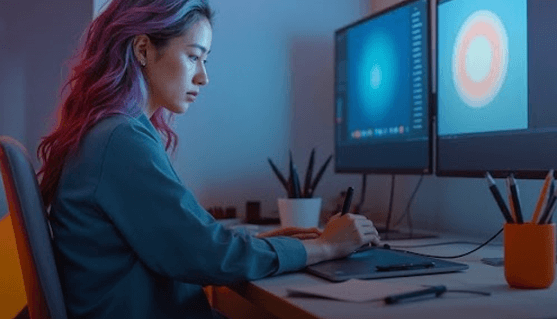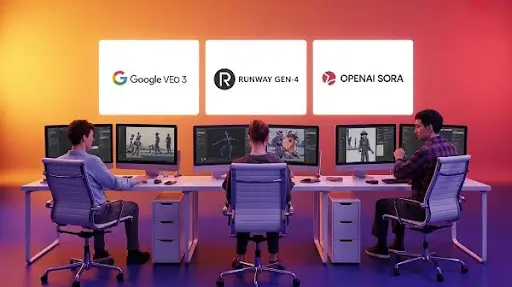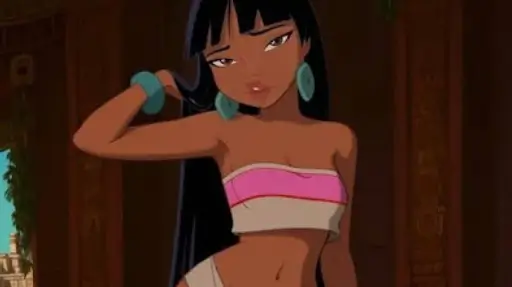Scroll through any screen, mobile, desktop, or digital billboard, and you’ll notice one thing: movement dominates attention. Static visuals quietly take a backseat as motion graphics step forward, not as an option, but as a necessity in visual communication.
By 2025, every corner of the economy—packed with advertising, streaming, SaaS tools, shops, classrooms, and hospitals—will need motion graphic design to stand out.
Yet the work isn’t simply about sliding logos or spinning text on screen. It’s about sharpening a story, giving a brand personality, and delivering info with style in the blink of an eye.
Motion graphics have matured into a strategic tongue-a mash-up of design and animate skill that nudges feelings and thoughts rather than just pixels.
What Are Motion Graphics in Today’s Digital Ecosystem?
At heart, motion graphics are moving visuals that carry messages, untangle dense data, or brighten a narrative. They marry classic design rules with movement, sound, and a mini-thread of storytelling.
Unlike full-length animation, which builds heroes and plots, motion graphics stay sharp, brief, and task-driven, shaped for the rapid scroll of today’s screens.
In 2025, the definition of motion graphics is stretching beyond traditional platforms. Think AR filters, virtual product demos, interactive social reels, explainer videos, immersive websites, and even smart packaging.
3D Motion Graphics
The clearest jolt in the field is the flood of 3D work. Designers and marketers now draft entire scenes, add lifelike textures, and whip cameras around to attract viewers.
This depth-profound in the frame and feeling gives product reveals and brand tales a fresh weight that flat graphics simply can’t touch.
Tools like Cinema 4D, Blender, and Unreal Engine now sit on the desk of nearly every serious motion-gfx pro. That familiarity lets studios swap the feel of pixel-perfect animation for one that brushes closer to real life, so the final video pulls viewers in and, more often than not, drives sales.
Why Motion Graphic Design Is a Non-Negotiable in 2025
Micro-Attention Spans Demand Macro-Impact Visuals
In a world dominated by 3-second swipes, motion graphic videos are the most efficient way to hook, hold, and hammer a message into the audience’s mind. A cleverly animated infographic or kinetic typography video can explain what 500 words can’t.
Cross-Platform Versatility
Whether the delivery screen is a smartphone feed, a dashboard pop-up, or a mall kiosk, the same playful layer of movement slips into TikTok ads, app micro-interactions, YouTube bumpers, and window graphics without missing a beat.
The same motion graphics example can live on multiple platforms in varying formats, ensuring maximum ROI.
High Information Retention
Studies show that visual content increases learning and retention by 400%. Drop a simple animation on top of plain data; engagement usually triples.
For that reason-and because fintech, health-tech, and SaaS stories tend to pack heavy concepts into tight word counts-brands lean hard on motion to make the meaning slide, not just sit.
Role of a Motion Graphics Designer in 2025
A motion graphic designer isn’t just a digital artist anymore; they’re a storyteller, marketer, and UX strategist. Their skill set now demands fluency in:
- Storyboarding for emotion and conversion
- Typography animation with intent
- Visual transitions that support brand tone
- Audio syncing that amplifies message retention
By working alongside strategists, product leads, and engineers, the motion team molds launch reels, pitch decks, onboarding walk-throughs, and dozens of other assets so the tone, timing, and look all speak the same brand language.
Most Popular Motion Graphics Examples in 2025
Looking for inspiration or clarity? These are some of the top motion graphics examples redefining digital design this year:
- App walkthroughs with animated pointers and live feature highlights
- Explainer videos for crypto and fintech with dynamic charts
- E-commerce ads using 3D motion graphics for product showcases
- Kinetic typography in Instagram Reels and shorts
- Digital OOH (out-of-home) animations on smart billboards
What Is Motion Graphics Video Production and Why Does It Matter?
Motion-graphics production covers the whole arc: sketching an idea, building the art, setting each layer in motion, and finally rendering the file for upload.
Nobody is shocked to hear that, by 2025, most studios will do those steps inside a shared cloud space while a friendly AI trims the fat from draft cuts.
So, a modern studio may gather creative directors, animators, writers, and sound designers in one virtual room because they chase the same metrics—conversions, reach, and recall. Frame serves not only the eyes but also the bottom line.
Stages of Motion Graphics Video Production
- Creative Brief & Goal Mapping
- Scripting & Storyboarding
- Style Frame Design
- Animation & Motion Passes
- Sound Design & VO Syncing
- Final Edits & Optimization for Platforms
Each step plays a pivotal role in ensuring that your motion graphics video doesn’t just exist, it performs.
How Motion Graphics Fit into Marketing Campaigns
Motion graphics aren’t just for aesthetic flex anymore. They’re strategic content pieces built to generate clicks, sales, and loyalty.
Here’s how brands use them across funnel stages:
- Top of Funnel (Awareness): Social ads, teaser trailers, animated banners
- Mid Funnel (Consideration): Product walkthroughs, explainer videos
- Bottom Funnel (Conversion): Offer highlights, benefit-based animations
- Post-Purchase (Retention): Onboarding animations, loyalty program explainer reels
Motion graphics link a brand’s message with what people actually want to watch, so marketers and agencies now treat them as must-have campaign assets.
Future Trends Shaping Motion Graphics in 2025
1. AI-Powered Motion Graphic Design
Artificial intelligence has moved beyond talk and settled into daily animation work. Designers call on smart tools to whip up rough storyboards, animate smooth scene shifts, or even dub voice tracks in new languages.
Apps such as Runway ML and Adobe Firefly shave days off the schedule while leaving creative steering in human hands.
AI also runs A/B tests on finished videos, quickly spotting which frames spark clicks and shares, making motion graphics feel as data-driven as they do art.
2. AR and VR Integration
In 2025, motion graphics design will not end on the screen. With AR and VR going mainstream, animated graphics will now live in real spaces, on packaging, signage, museum installations, and virtual events. Brands will use 3D motion graphics layered in augmented spaces to educate, engage, and excite.
For example, a consumer pointing their phone at a product box and seeing a floating motion graphics video explaining how to use it, that’s not future tech anymore. It’s happening now.
3. Responsive Motion Design for UX/UI
Thanks to motion graphics, modern websites and apps are alive. These insights have brought together UX and motion designers.
Now, animated page turns, scroll-triggered hints, loading loops, and tiny micro-interactions smooth the journey, steer attention, and lend apps and sites a polished, high-end vibe.
Want to improve app onboarding? Add a motion graphics video. Want to explain a feature? Use a GIF-style animation in your UI. Small animations, massive impact.
What Tools Do Motion Graphics Designers Use in 2025?
Here’s a look at what’s currently powering the motion graphics world. Every motion graphics designer needs at least a few of these in their arsenal:
Top Tools in 2025
- Adobe After Effects – Industry standard for 2D animation
- Cinema 4D – High-quality 3D motion graphics production
- Blender – Free and powerful for modeling, animation, and rendering
- Adobe Premiere Pro – Seamless editing for final video output
- Figma with Motion Plugins – For responsive UI/UX motion prototyping
- Runway ML – AI video editing and motion enhancement
- Notch – Real-time graphics, used for concerts and immersive installations
How to Choose the Right Motion Graphics Company?
Outsourcing your project? Don’t just pick any vendor. A professional motion graphics company brings more than software skills; they bring storytelling clarity, production speed, and audience insight.
Key Things to Look for:
- A strong portfolio with diverse motion graphics examples
- Expertise in both 2D and 3D motion graphics
- Clear process and milestone-based delivery
- Creative direction that aligns with your brand tone
- Scalability across multiple content formats
Partnering with a seasoned studio keeps color, style, and tone steady across social posts and trade-show screens.
Motion Graphics Video vs. Traditional Animation: What’s the Difference?
Many brands confuse motion graphics video with traditional animation, but fundamental differences exist.
Key Differences:
|
Aspect |
Motion Graphics |
Traditional Animation |
| Focus | Text, icons, shapes | Characters, narratives |
| Usage | Explainers, promos, UI | Films, series, storytelling |
| Duration | Short-form | Long-form |
| Production Time | Shorter | Longer |
| Cost | More budget-friendly | Higher costs |
Motion graphics win if you aim for clarity, speed, and ROI.
FAQs Around Motion Graphics in 2025
What is graphic design’s role in motion graphics?
Graphic design is the foundation of motion graphics. Typography, composition, branding, and visual hierarchy all come from graphic design. Motion simply brings those elements to life.
What are motion graphics used for in 2025?
- Brand storytelling
- Product demos
- Data visualizations
- UI animations
- Digital ads
- Corporate presentations
- Event visuals
- Social media reels
Can motion graphics help increase sales?
Absolutely. When the final piece is sharp, audiences stay longer, grasp value sooner, and remember the brand, often increasing conversion numbers.
Is 3D motion graphics hard to learn?
Working in 3D definitely feels trickier at first than plain 2D work, yet free programs such as Blender, endless online tutorials, and ready-made templates now make the leap pretty manageable. That's why plenty of designers begin life in 2D and then ease into 3D motion graphics when they want an extra punch.
Where can I find the best motion graphics inspiration?
Check out:
- Motionographer – For industry-level work
- Behance Motion Graphics Gallery – From global designers
- Art of the Title – For cinematic motion design
Bulletproof Tips for Successful Motion Graphics Production
Before Production:
- Define your goal (conversion, awareness, engagement)
- Create a strong script, clarity beats cleverness
- Lock in brand tone and visual style
During Production:
- Use layered project files for flexibility
- Maintain pacing, 2 to 3 words per second in voiceovers
- Keep animations consistent with transitions and movement rules
After Production:
- Optimize videos for mobile (subtitle-ready, short)
- Split longer videos into micro-content
- A/B test visuals across platforms
Final Words
In an era where movement carries meaning, your brand can’t afford to sit still. Motion graphics aren’t merely a fad; they’re quickly becoming the backbone of digital communication, design, and storytelling. They weave creativity with strategy, good looks with results, and style with real substance.
Prolific Studio, one of the best animation studios in Miami, is here to lead the way if you’re ready to transform your message into motion and design into action.
From motion graphic design to full-blown motion graphics video production, our team delivers visuals that do more than look good; they perform. Contact now.
Related Article:








